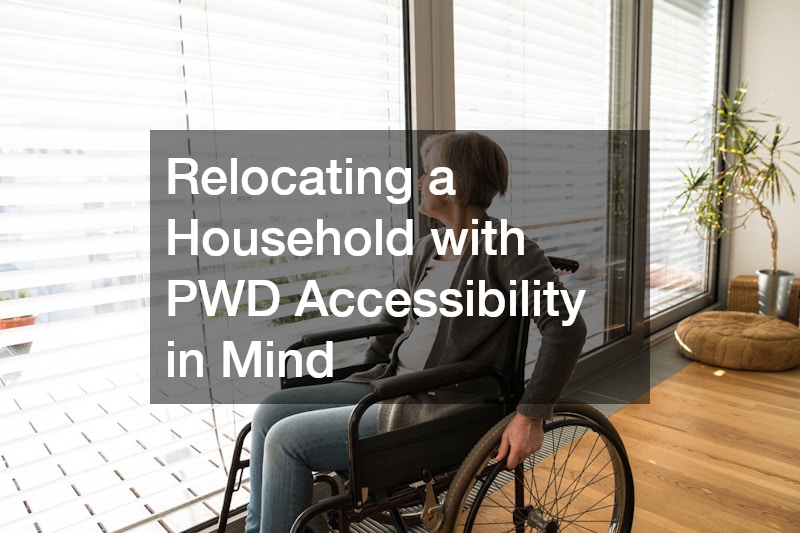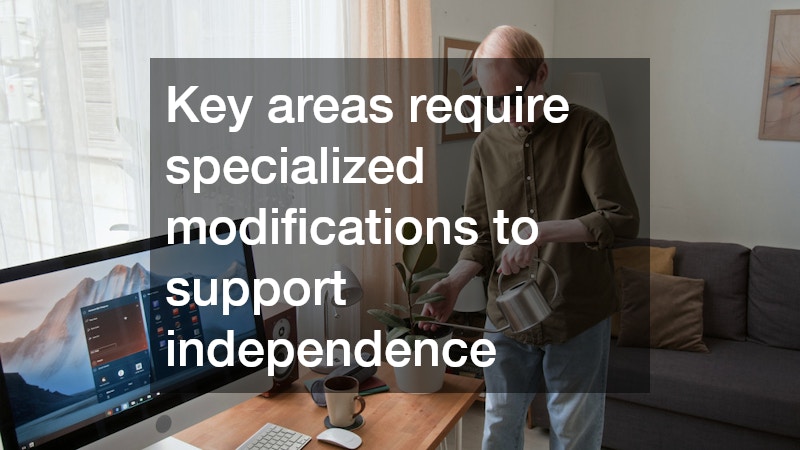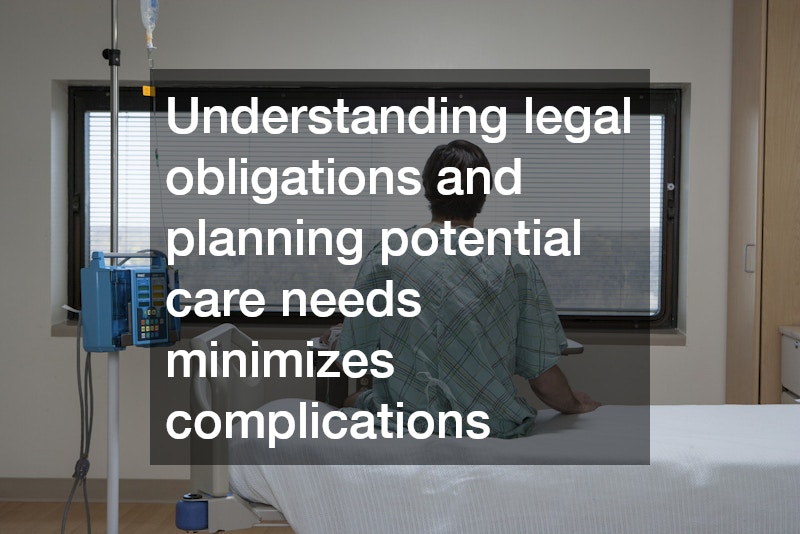Relocating a household can be a complex undertaking under any circumstances, but when a family member has a disability, the stakes are higher. Accessibility, safety, and comfort must be prioritized from the moment you begin planning your move until your family is fully settled in the new space. Making the transition smooth requires strategic planning, thoughtful home modifications, and coordination with both service providers and legal advisors.
This guide offers a comprehensive roadmap for relocating with accessibility in mind. It covers selecting a suitable home, organizing the move, preparing the new environment, integrating safety and comfort features, and planning for long-term care.
Planning Your Accessible Move
Selecting a home that meets the needs of a person with disabilities is the first step toward a smooth transition. Accessibility should be a core factor in choosing a property.
Choosing the right space:
-
Look for single-floor layouts or new apartments with elevators for multi-level buildings.
-
Prioritize wide doorways, open floor plans, and barrier-free entryways.
-
Ensure bathrooms and kitchens are easily accessible and can accommodate mobility aids.

Organizing the move:
-
Hire a local long distance mover to handle packing, transportation, and placement of heavy or fragile items.
-
Clearly label boxes containing accessibility equipment or essential medical devices to ensure they are unpacked first.
-
Create a checklist to track furniture placement, mobility aids, and specialized equipment like shower chairs, ramps, or lifts.
Packing tips for accessibility:
-
Pack essentials separately in a “first-day kit,” including medications, medical supplies, and personal devices.
-
Avoid stacking boxes in pathways or doorways during the move.
-
Keep a floor plan of the new home handy to pre-assign furniture and equipment placement.
Proper planning minimizes stress, ensures safety, and allows your family to maintain daily routines during the transition.
Choosing a Reliable Long-Distance Moving Service
For families moving across cities or states, selecting a long distance mover with experience in accessibility needs is crucial.
Vetting moving companies:
-
Ask about experience moving households with specialized equipment or mobility devices.
-
Verify if a potential local long distance mover has insurance coverage for fragile items and medical equipment.
-
Request references from previous clients with similar accessibility requirements.
Coordination strategies:
-
Schedule the move to minimize disruption, preferably on weekdays or when caregivers can provide support.
-
Confirm that the moving team understands the layout and any special instructions for handling equipment.
-
Plan for temporary accommodations if renovations or adjustments in the new home are necessary before the family moves in fully.
A well-chosen moving company can significantly reduce stress and prevent potential damage to both the home and accessibility equipment.
Preparing the New Home for Accessibility
Before bringing belongings into a new residence, it’s essential to prepare the space to meet accessibility needs.
Surface improvements:
-
Concrete resurfacing can create smooth, slip-resistant pathways, ramps, and driveways. This prevents trips and falls and ensures easy navigation for wheelchairs, walkers, or scooters.
Entrances and mobility:
-
Custom garage door installation can provide automated, easy-access entry. Consider doors with wide openings and smart controls for safety and convenience.
-
Clear entryways, level thresholds, and properly spaced furniture improve movement within the home.
Additional preparation tips:
-
Remove loose rugs or clutter that could pose tripping hazards.
-
Install adequate lighting at entrances, hallways, and staircases.
-
Consider wider hallways or doorways for long-term accessibility planning.
Pre-move modifications allow the new home to function safely from day one, reducing stress for both the family and the household member with disabilities.
Renovating Key Spaces for Daily Use
Key areas like bathrooms and kitchens often require specialized modifications to support independence and safety.
Bathroom renovations:
-
Working with a professional bathroom remodeler ensures proper installation of walk-in showers, grab bars, non-slip flooring, and accessible vanities.
-
Consider lever-style handles for faucets and adjustable showerheads for easier use.
-
Place storage at reachable heights to minimize bending or stretching.
Climate control improvements:
-
A local AC company can assess and install air conditioning systems that maintain safe temperature ranges, improve air circulation, and reduce humidity.
-
Programmable or automated systems can ensure consistent comfort without frequent manual adjustments.
Additional kitchen and common area tips:
-
Lower or adjustable countertops for ease of use.
-
Lever handles for cabinets and appliances with clear, tactile controls.
-
Adequate lighting and uncluttered pathways to minimize risks during daily activities.
These renovations not only improve functionality but also enhance comfort and independence.
Incorporating Technology for Safety and Communication
Technology plays a key role in maintaining safety and peace of mind for PWD household members.
Emergency communication:
-
An intrinsically safe phone is designed to function safely in potentially hazardous or wet environments. Installing such phones near bathrooms or kitchens ensures immediate access to help when needed.
Smart home integration:
-
Integrate alerts, motion sensors, and automated doors for additional security.
-
Use local AC company expertise to connect smart thermostats and climate systems with remote monitoring.
-
Devices can be linked to caregivers or family members to provide real-time updates on activity and safety.
Other technology considerations:
-
Automated lighting in hallways and rooms.
-
Voice-activated controls for appliances, doors, and security systems.
-
Remote monitoring for health tracking and emergency response.
Implementing technology alongside structural modifications creates a safer, more comfortable environment for everyone in the household.
Legal and Compliance Considerations
Relocating a household with accessibility in mind involves more than physical adjustments; it also requires careful attention to legal and regulatory requirements. Ensuring compliance with housing laws and safety standards protects both the household members and the family from potential liabilities while supporting a smooth transition to the new home.
Legal Support
-
Lease agreements and tenant rights: Consulting a law firm can help families review and negotiate lease terms for accessibility features in new apartments. This includes confirming provisions for ramps, wider doorways, or other modifications in rental properties and ensuring landlords cannot deny reasonable accommodations under fair housing laws.
-
ADA compliance and accessibility standards: Legal advisors can explain how the Americans with Disabilities Act (ADA) and local accessibility codes apply to both rentals and owned properties. This ensures that bathrooms, kitchens, doorways, and common areas meet safety and usability requirements for household members with disabilities.
-
Contracts for services: When hiring contractors, moving companies, or remodeling professionals, a law firm can review service agreements to protect the family’s interests. Clear contracts specify responsibilities for modifications such as bathroom remodels, custom garage door installation, or concrete resurfacing, helping to prevent disputes or unexpected costs.
Planning for Future Care
-
Assisted living research: Investigate local assisted living facilities to understand available service levels, eligibility requirements, and long-term care options. Knowing what support exists locally allows families to plan a transition if the household member’s needs increase over time.
-
Home design for future modifications: Ensure that the new residence can accommodate potential changes, such as installing lifts, widening doorways, or creating accessible bathrooms, should assisted living support eventually become necessary. Planning ahead reduces the need for costly retrofits or sudden relocation in the future.
-
Documentation and compliance tracking: Maintain records of legal consultations, contracts, and accessibility modifications. This documentation can support compliance with regulations, insurance claims, and any future interactions with service providers or housing authorities.
By proactively addressing legal obligations and planning for potential future care, families minimize complications, ensure the home remains safe and accessible, and protect the rights and interests of household members. Careful legal planning, combined with thoughtful home modifications and research into local assisted living facilities, establishes a secure foundation for both immediate needs and long-term well-being.
Coordinating Healthcare and Support Services
A successful relocation for a household with a family member who has disabilities requires more than just moving furniture and installing accessibility modifications. Coordinating healthcare and support services in the new location is critical to ensure continuity of care, maintain independence, and reduce stress during the transition.
Establish Local Contacts
Before and immediately after the move, it’s essential to identify and connect with local healthcare providers:
-
Physicians and specialists: Research nearby primary care doctors, specialists, and urgent care facilities to ensure ongoing medical care is accessible. Verify which providers accept insurance and whether they have experience treating patients with specific mobility or cognitive needs.
-
Physical therapy: Locate local physical therapists who can provide rehabilitation, mobility support, or preventative therapy. Scheduling initial consultations before the move can help create a care plan tailored to the household member’s needs.
-
Pharmacies: Identify conveniently located pharmacies for prescription refills and over-the-counter medication. Check if they offer home delivery or curbside pickup to minimize unnecessary travel.
-
Introductory visits: Schedule meetings or assessments before the household member fully settles in the new home. This ensures providers are familiar with any mobility aids, accessibility requirements, or medical devices, creating a smoother transition.
Supplemental Care
Even with a well-prepared home, additional support may be needed during and after the move:
-
Local assisted living facilities: These can provide part-time or temporary support while the household adjusts. Services may include physical therapy sessions, personal care assistance, meal preparation, and social engagement activities, reducing the burden on family members.
-
Emergency communication: Integrating intrinsically safe phones into the home ensures household members can quickly contact caregivers or emergency services if needed. These phones are especially useful in areas where moisture or electrical hazards might pose a risk, such as bathrooms or kitchens.
Scheduling and Routine Planning
Effective scheduling prevents conflicts and ensures healthcare needs are consistently met:
-
Coordinating appointments: Align physical therapy, doctor visits, and other essential appointments with moving and unpacking schedules to reduce disruption and stress. Avoid overloading the household member on any single day.
-
Shared calendars: Maintain a digital or physical calendar accessible to all caregivers and family members. Include appointment times, therapy sessions, medication reminders, and service visits. This helps everyone stay informed and ensures no tasks are overlooked.
-
Routine planning: Establish consistent daily routines that incorporate healthcare, mobility exercises, and recreational activities. Stability is particularly important during a move, as changes in environment can increase anxiety or disorientation for household members with disabilities.
Post-Move Adjustments and Continuous Assessment
Even after the household is fully settled, maintaining accessibility and comfort requires ongoing attention. People’s needs, mobility, and health can change over time, so a one-time adjustment is rarely sufficient. A proactive approach helps prevent accidents, supports independence, and ensures that the home continues to function optimally for household members with disabilities.
Review Completed Modifications
After the move and initial renovations:
-
Bathroom remodeler work: Double-check that all modifications—walk-in showers, grab bars, raised toilet seats, and non-slip flooring—are installed correctly and meet the specific accessibility requirements. Test faucets, showerheads, and cabinetry for ease of use and adjust if necessary. Small adjustments, like repositioning grab bars or lowering towel racks, can significantly improve safety and comfort.
-
HVAC systems: Work with your local AC company to confirm that air conditioning, heating, and ventilation systems are functioning properly. Ensure thermostats are accessible, programmable features are correctly set, and airflow reaches all areas of the home. Consistent climate control prevents discomfort and can reduce health risks for individuals sensitive to temperature extremes.
-
Technology and communication: Test any devices installed for safety, including intrinsically safe phones or alert systems. Verify that emergency numbers are programmed correctly and that family members or caregivers know how to respond if the system is triggered.
Continuous Assessment Tips
Ongoing evaluation ensures that modifications continue to meet evolving needs:
-
Safety inspections: Conduct regular checks of high-traffic areas, particularly bathrooms, kitchens, hallways, and entryways. Look for wear and tear on flooring, loose rugs, or furniture that may obstruct movement. Ensure lighting remains adequate, replacing bulbs as needed, and check that all accessibility features, such as ramps or railings, remain stable.
-
Adjust furniture and equipment: As household members’ mobility changes, rearrange furniture, move equipment, or upgrade mobility aids. For example, as a person’s balance or strength changes, a walker or wheelchair may require more clearance in hallways or doorways. Periodically review the layout to maintain smooth, safe pathways.
-
Maintenance and follow-up: Maintain a schedule for ongoing maintenance of installations and systems. This includes contacting contractors or service providers for minor repairs, such as tightening grab bars, servicing HVAC systems, or resurfacing concrete pathways to prevent cracking.
-
Update emergency and contact information: Ensure emergency contacts, healthcare providers, and service providers are current. Review the contact list quarterly and make sure everyone in the household knows where to find it. Include numbers for local support services, moving companies, or maintenance specialists who understand accessibility needs.
-
Document changes and observations: Keep a journal of modifications, maintenance, and observed challenges. Recording patterns—like frequent trips to the bathroom or areas where furniture is difficult to navigate—helps plan future adjustments or renovations.
By regularly reviewing modifications, conducting safety checks, adjusting layouts, and keeping all systems and contacts up-to-date, families can maintain a home that continues to be safe, accessible, and comfortable. This proactive, structured approach ensures long-term independence and peace of mind for both the household member with disabilities and their family.
Relocating a household with accessibility in mind requires careful planning, proactive home modifications, and coordination with professionals. From selecting a suitable home and reliable movers to preparing key areas and integrating safety technology, each step contributes to a safer, more comfortable environment. Legal compliance and ongoing healthcare coordination further support independence and well-being.
Combining thoughtful renovations, strategic moving logistics, and technology solutions ensures a smooth transition while prioritizing safety, accessibility, and quality of life for the household member with disabilities.




